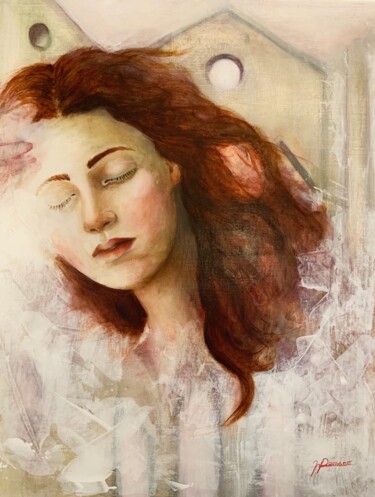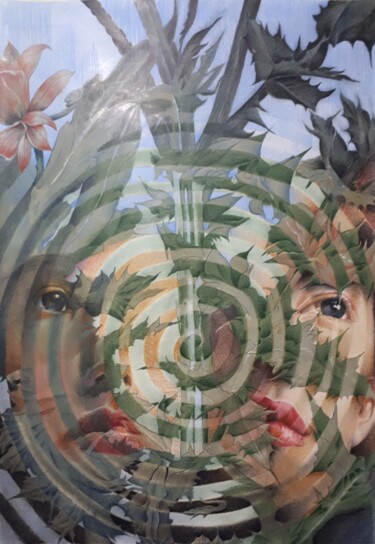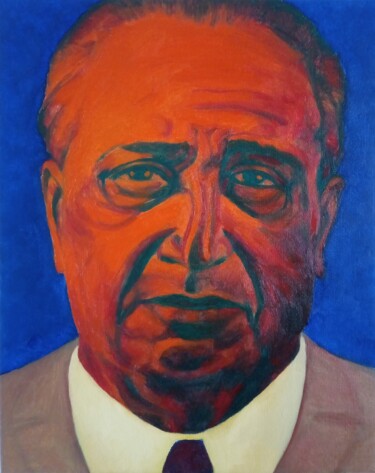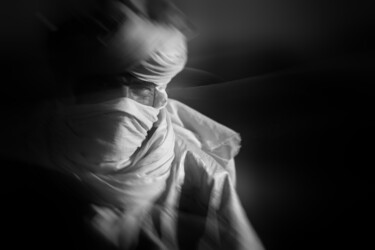Ah, the portrait! Yes, you, dear portrait, who are an open window to the past, a bridge between who we were and who we longed to appear as. What is this extraordinary genre if not the art of capturing in a painting everything we wish could last forever? Beauty, power, wealth, personality: every brushstroke tells a story, and these stories—let’s admit it—change from place to place, from era to era, revealing the dreams and ambitions of those who chose to remain “still for eternity.”
And so, waking up bright and early on the right side of the bed (fortunately not the wrong one), I thought to myself: “Why not take you on a journey through the four great traditions that made portraiture a superstar in the history of art?”
Are you ready to explore the splendor of the Italian Renaissance with its divine elegance, the almost obsessive precision of Dutch Flemish painting, the regal and sumptuous theatricality of Spain, and finally, the worldly, impeccable refinement of England? I certainly am—so let’s begin!
The Italian Renaissance represents one of the brightest moments in the history of art, a time when portraiture became an autonomous form of artistic expression. During the 15th and 16th centuries, the portrait went beyond mere physical representation to reflect the cultural and humanistic rebirth of the era. Italy experienced an explosion of creativity: thanks to masters like Leonardo da Vinci, Raphael, and Titian, portraits not only captured the physical features of their subjects but also explored their interiority.
Leonardo, for instance, with his famous Portrait of Ginevra de’ Benci, combined atmospheric perspective with subtle psychological insight, creating a figure both real and ideal. Raphael achieved a perfect synthesis of grace and humanity, while Titian revolutionized the use of color to express the vitality and character of his subjects, as seen in his Equestrian Portrait of Emperor Charles V.
In 15th-century Holland, Flemish painting elevated portraiture to a new level of technical precision. Jan van Eyck, for example, in his renowned The Arnolfini Portrait, demonstrated how every detail—from the texture of fabrics to the reflection in a mirror—could tell a story. The use of oil paint, a groundbreaking Flemish innovation, enabled extraordinary rendering of light and materials, bringing the paintings to life. Rogier van der Weyden, on the other hand, introduced a deeply emotional and symbolic dimension to his works, elevating portraiture to a form of visual meditation.
In 18th-century England, portraiture became a celebration of social and personal prestige, reflecting the intricate stratification of neoclassical society. Joshua Reynolds and Thomas Gainsborough dominated the artistic scene, reinterpreting their subjects through allegorical or pastoral lenses, rendering them both ideal and intimate.
Reynolds, for example, used poses inspired by the great Italian Renaissance masters but added a romantic touch that emphasized the character and rank of his subjects. Gainsborough, renowned for his skill in depicting nature, created idyllic settings that harmonized with his sitters, as seen in his famous The Blue Boy. Similarly, the tradition of English royal portraiture, such as the depictions of Queen Elizabeth I, combined symbolic grandeur with realistic detail, underscoring the monarchy’s importance as a pillar of national stability.
Spain’s Siglo de Oro represents one of the pinnacles of European portraiture. Diego Velázquez, the preeminent master of the genre, revolutionized the very concept of portraiture with works like Portrait of Pope Innocent X and Las Meninas. These portraits went beyond mere likeness; Velázquez captured the psychological and social complexity of his subjects, creating images that vibrate with life.
In Golden Age Spain, portraiture was closely tied to the court and aristocracy, but Velázquez broke traditional conventions, portraying even court jesters and marginalized figures with the same dignity reserved for nobility, demonstrating a rare and moving humanity.
In this discussion, we will analyze an emblematic portrait from each of these traditions, highlighting the stylistic, technical, and conceptual differences that emerge from these extraordinary works. This comparison will guide us in discovering the cultural roots and aesthetic visions that shaped portraiture over the centuries, revealing its timeless artistic and symbolic value.
Prepare for a journey that spans centuries, artistic schools, and the hearts of great masters! Examples will be drawn from the Italian, Dutch, Spanish, and English traditions.
 Filippo Lippi, Female Portrait, 1445. Tempera on panel, 49.3 × 32.7 cm. Gemäldegalerie, Berlin
Filippo Lippi, Female Portrait, 1445. Tempera on panel, 49.3 × 32.7 cm. Gemäldegalerie, Berlin
Italy
The Italian Renaissance represents one of the brightest moments in the history of art, an era when portraiture gained unprecedented significance. During this period, the focus on the individual and their representation was not merely an aesthetic endeavor but a profound expression of the rediscovery of humanity as the center of the universe. Renaissance portraits are distinguished by their pursuit of a perfect balance between idealization and realism. Artists did not merely depict the physical traits of their subjects but sought to capture their soul, personality, and essence. The masterful use of perspective, anatomical details, and light imbued these works with a sense of depth and vitality never seen before.
Portraits were often accompanied by backgrounds rich in symbolism: classical architecture symbolizing stability and the order of knowledge, or natural landscapes linking humanity to the divine. The elegance of the lines and the delicacy of the colors transformed each work into a celebration of human beauty and dignity.
Now, allow me to introduce you to a work that embodies these characteristics perfectly: the Female Portrait attributed to Filippo Lippi, dated around 1445 and housed in the Gemäldegalerie in Berlin. Looking at it, one is left breathless—it feels as though time itself has stopped in the face of its grace.
The woman’s profile is a triumph of harmony and delicacy. Her face, sculpted by light, emerges with a perfection that seems to defy reality. The architectural background, featuring a niche adorned with a shell and a landscape visible beyond, adds depth and grandeur to the scene. And those colors! They are vibrant yet subtle, creating an atmosphere suspended between the real and the divine.
As I approach the painting, for a moment, I feel as though it is alive. The volume of the figure is so skillfully rendered that it seems it could almost step off the panel. Instinctively, I want to reach out and touch it, just to convince myself I’m not dreaming. How can a work of such modest dimensions hold such immense greatness? It is as if Filippo Lippi captured eternity in a single glance.
Yet, there is also an air of mystery: who is this woman? We do not know, but we cannot help but feel connected to her, as though she gazes at us with an elegance that transcends centuries.
This work is more than just a portrait: it is a declaration of love for art, beauty, and humanity. A masterpiece that continues to inspire awe, reminding us why the Renaissance remains synonymous with perfection to this day.
 Filippo Lippi, Portrait of a Woman with a Man at a Casement, 1435–1436. Tempera on panel, 64.1 x 41.9 cm. The Metropolitan Museum of Art, New York.
Filippo Lippi, Portrait of a Woman with a Man at a Casement, 1435–1436. Tempera on panel, 64.1 x 41.9 cm. The Metropolitan Museum of Art, New York.
Why does the subject of this painting immediately remind me of another equally fascinating work? I’m referring to a model with similar features—elegant, blonde, and mysterious—who is the protagonist of Filippo Lippi’s extraordinary masterpiece, Portrait of a Woman with a Man at a Casement, created around 1435–1436 and now housed at The Metropolitan Museum of Art in New York.
This remarkable painting combines the elegance of Italian Renaissance portraiture with Northern influences, evident in the meticulous attention to detail and the architectural and landscape background. The richly dressed and adorned woman gazes forward with majestic poise, while a man peers from the casement, creating an enigmatic visual dialogue. However, their eyes do not meet, adding a layer of mystery to the composition.
The work, likely commissioned to commemorate a marriage, reflects the social values of the time and is the first known double portrait in Italy. It showcases an innovative use of perspective and landscape inspired by Flemish painting. Filippo Lippi crafts a scene that feels suspended and theatrical, captivating the viewer with its perfection and mystery, turning this painting into an eternal snapshot of history and emotion.
Now, let’s move on to explore the Netherlands!
 Jan van Eyck, Portrait of a Man with Carnation, 40 x 31 cm, c. 1436. Gemäldegalerie, Berlin.
Jan van Eyck, Portrait of a Man with Carnation, 40 x 31 cm, c. 1436. Gemäldegalerie, Berlin.
Netherlands
What are the differences between Italian Renaissance portraiture and Flemish portraiture of the 15th century? To uncover this, we revisit the well-known female portraits by Filippo Lippi and compare them to the male portrait attributed to Jan van Eyck or his workshop.
It becomes evident that Italian portraits, such as "Portrait of a Lady" and "Portrait of a Woman with a Man at a Casement", embody the Renaissance ideals of beauty, grace, and virtue. The figures, depicted in profile with a solemn and classical composition, reflect the humanism of the era, which celebrated harmony and perfection. Filippo Lippi enriches his works with architectural and landscape backgrounds, such as the shell niche or the bird’s-eye view of the countryside, adding depth and enhancing their symbolic and narrative value while underscoring the social status of the subjects.
In stark contrast, the "Portrait of a Man with Carnation" stands out for its meticulous realism and celebration of individuality. The male subject, portrayed frontally or slightly in three-quarters view, is defined by extremely precise details: wrinkles, rough skin, and imperfections, which emphasize the uniqueness of the face. Here, there are no elaborate backgrounds; the focus is entirely on the figure, accentuated by a dark backdrop that amplifies the subject’s three-dimensionality. The oil painting technique, a Flemish innovation, allows for an extraordinary rendering of light, textures, and symbolic objects, such as the carnation, a marriage emblem, or the medallion of the Order of Saint Anthony, signifying the subject’s rank.
Moreover, the colors and techniques further underline the differences between the two schools. The tempera on panel used by Lippi provides vivid yet delicate tones, ideal for expressing the luminosity and elegance characteristic of Italian figures. In contrast, Flemish oil painting offers chromatic depth and an attention to light that creates an almost photographic effect. The richness of detail in Flemish portraiture is evident not only in facial features but also in the symbolic objects, making each element a key part of the composition.
 Jan van Eyck, Portrait of Giovanni Arnolfini, c. 1440. Oil on panel, 29 × 20 cm, Gemäldegalerie, Berlin.
Jan van Eyck, Portrait of Giovanni Arnolfini, c. 1440. Oil on panel, 29 × 20 cm, Gemäldegalerie, Berlin.
Curiosity: In the same masterful style of the Flemish master, we find the "Portrait of Giovanni Arnolfini", an oil on panel created around 1440 and housed in the Gemäldegalerie in Berlin. Giovanni Arnolfini, does the name ring a bell? That’s right, it’s him: the wealthy Lucchese merchant residing in Bruges, famously known as the protagonist, alongside his wife, of the celebrated painting "The Arnolfini Portrait", also by Jan van Eyck, now held in the National Gallery in London.
 Diego Velázquez, Portrait of Infante Philip Prospero, 1659. Oil on canvas, 128.5 × 99.5 cm, Kunsthistorisches Museum, Vienna.
Diego Velázquez, Portrait of Infante Philip Prospero, 1659. Oil on canvas, 128.5 × 99.5 cm, Kunsthistorisches Museum, Vienna.
 Diego Velázquez, Portrait of Infanta María Teresa of Spain, 1652–53. Oil on canvas, Kunsthistorisches Museum, Vienna.
Diego Velázquez, Portrait of Infanta María Teresa of Spain, 1652–53. Oil on canvas, Kunsthistorisches Museum, Vienna.
Spain
Curiosity: During the Siglo de Oro, Spanish portraiture focused primarily on the royal court, using art as a tool to consolidate the power and image of the monarchy. Velázquez, as the court painter, revolutionized the genre by introducing an unprecedented depth of humanity and sensitivity. In his portraits, royals are not mere symbols of divine power but complex individuals with emotions, fragility, and stories.
Spanish portraiture during the Siglo de Oro, particularly in Velázquez’s works, stands out for its ability to merge solemnity with intimacy, especially in portraits of royals. These paintings go beyond formal representation to become profound psychological and symbolic explorations, capturing not only the status but also the humanity of the subjects.
In the Portrait of Infante Philip Prospero, son of Philip IV of Spain, Velázquez depicts a two-year-old child with a melancholic and delicate aura. The young prince, destined for an early death, is portrayed in a sumptuous outfit, symbolizing his rank, surrounded by meaningful details such as the dog sitting beside him, a symbol of loyalty and innocence. The composition is understated, with a dark background that directs attention to the fragile, intensely illuminated figure of the child. Velázquez masterfully combines the formality of a royal portrait with extraordinary sensitivity, conveying the vulnerability of the young prince and his fleeting destiny.
The Portrait of Infanta María Teresa, also the daughter of Philip IV, presents a fourteen- or fifteen-year-old young woman already shaped by the responsibilities and expectations of her dynastic role. The princess is depicted in an elaborate gown, with details like the two watches attached to her outfit and the scarf in her left hand symbolizing her rank and the timeless nature of royalty. Similarly, the dark background and the interplay of light and shadow emphasize her figure, creating an aura of solemnity and grandeur. Despite her young age, the infanta appears authoritative and fully aware of her role, a testament to Velázquez’s ability to capture both the aesthetic and psychological essence of his subject.
 Joshua Reynolds, The Strawberry Girl, 1773.
Joshua Reynolds, The Strawberry Girl, 1773.
 Joshua Reynolds, Lady in Blue, c. 1775–1785. Oil on canvas, 76.5 cm × 63.5 cm. Hermitage Museum, St. Petersburg.
Joshua Reynolds, Lady in Blue, c. 1775–1785. Oil on canvas, 76.5 cm × 63.5 cm. Hermitage Museum, St. Petersburg.
England
During the English Neoclassical period, portraiture emerged as one of the most sophisticated and distinctive forms of art, thanks to painters like Joshua Reynolds and Thomas Gainsborough. Both artists, though employing different approaches, contributed to shaping the image of the social and cultural elite of the time, revealing a blend of elegance, sensitivity, and stylistic innovation.
"The Strawberry Girl" by Joshua Reynolds, created in the 1770s, is one of his celebrated “fancy pictures,” portraits of children often idealized and placed in sentimental or idyllic contexts. The girl, apparently inspired by a strawberry seller, is depicted with an innocent and direct expression, captivating the viewer with her sweetness. However, the context is far removed from the urban reality of her presumed origin: she is portrayed in a pale muslin dress and a turban, elements that evoke an almost exotic atmosphere.
Reynolds, renowned for his ability to blend emotion and formality, transforms a humble subject into an iconic figure, imbuing her with symbolism. The fragility of childhood and the passage of time become central themes of the painting, evoking the concept of vanitas.
"Portrait of a Lady in Blue", created in the late 18th century by Thomas Gainsborough, represents the refined style of Gainsborough, known for his ability to combine aristocratic elegance with personal intimacy. The woman, dressed in a sumptuous blue gown, is immersed in an aura of grace and delicacy. The soft, minimally detailed background is a deliberate choice that emphasizes the figure and her almost ethereal presence.
Although the subject remains unknown, some art historians speculate that she may be the Duchess of Beaufort. Gainsborough’s mastery lies in his ability to balance realism with idealization: the facial details are vivid, yet the entire portrait is enveloped in a romantic and luminous atmosphere, accentuating the beauty and status of the woman. His skillful use of shading and soft contours renders the painting almost poetic, a hallmark of the artist’s work.


 Olimpia Gaia Martinelli
Olimpia Gaia Martinelli















































